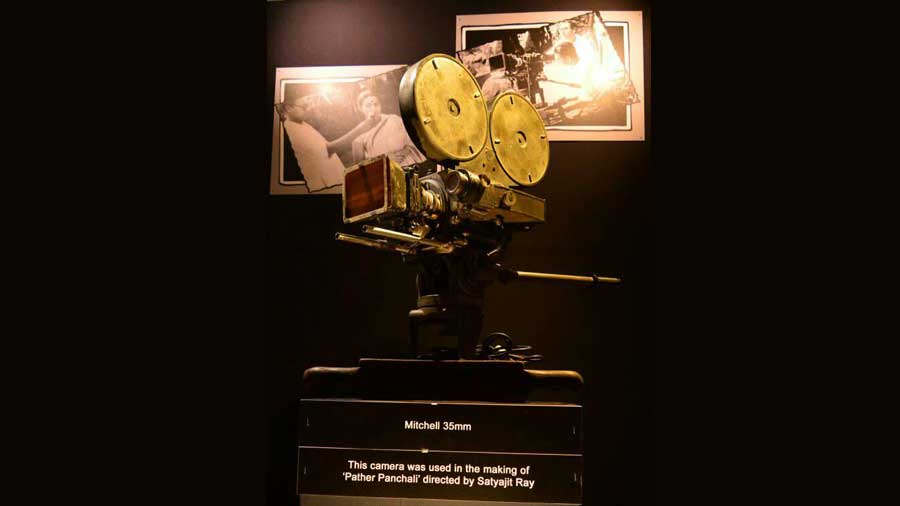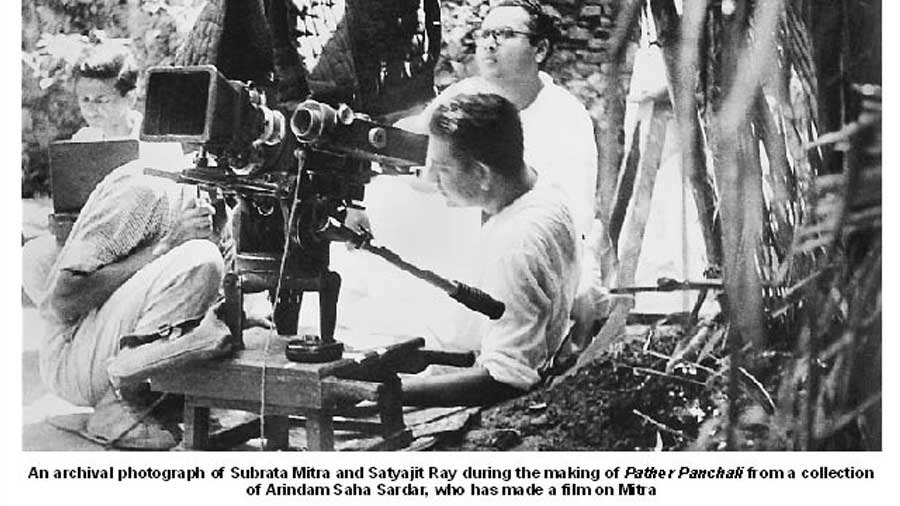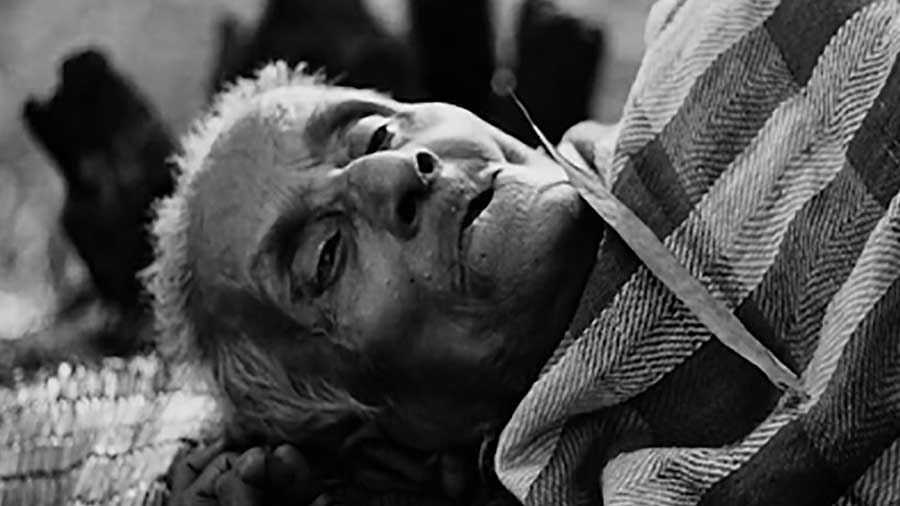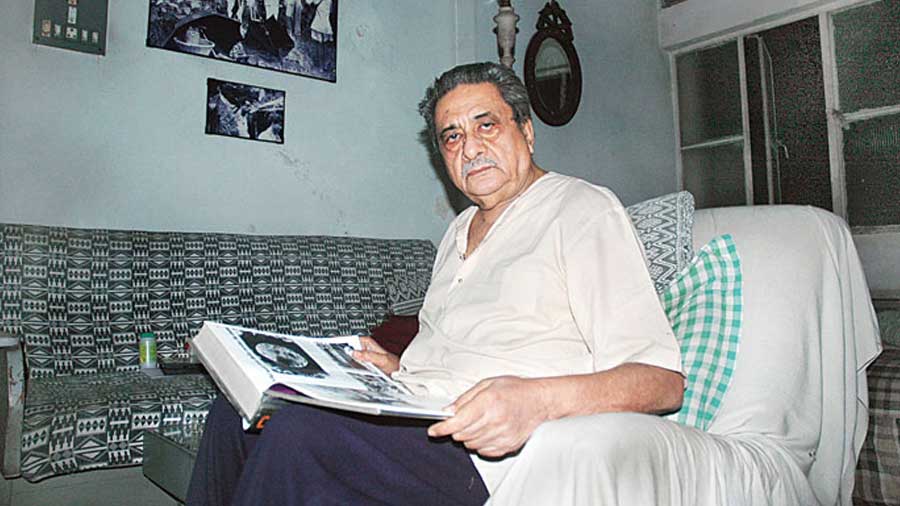Soumendu Roy became Satyajit Ray’s cinematographer after Subrata Mitra’s departure. An apprentice and assistant to Subrata Mitra in Pather Panchali, he recalls his experience, lugging the Mitchell, being treated to langcha by Ray, and Shanti Chatterjee using snuff to make ‘Durga’ sneeze…
Satyajit Ray had just resumed work on Pather Panchali, with the Government of West Bengal as producer. I had started my career about six months ago – and was almost a novice when I joined the unit of Pather Panchali. I was not involved during the earlier work on the film, which Manik-da first started shooting with a wall camera. When work had to be stopped for want of funds, Manik-da met producer after producer. But he was a new director. Moreover, there was no song in the film. As usual, nobody came forward. In his own writing, Manik-da has said there was no formal script for the film. Anyway, with help from Dr Bidhan Chandra Roy, work began again.
Manik-da had hired the Mitchell camera from Technicians’ Studio where I was an apprentice. On behalf of the studio, I was entrusted with the job of looking after the camera. That is how I came in contact with him. I met Satyajit Ray, Bansi Chandragupta, Subrata Mitra and others. I did not know much about them. I had just heard about them from Kanu Bandyopadhyay – in fact, overheard, as he was talking to someone. He was saying, ‘I am working on a film – Bibhutibhushan’s Pather Panchali. Looks like it is going to be a film with a difference.’ Once I joined the team – though I had little experience – I could not help feeling it was not going to be like any other traditional Bengali film. There was no artifice, no make-up; not much of hullabaloo over lights, etc., in the studio. Even the dialogues were commonplace, minimalist; as if everything was easy-going and natural.

The Mitchell camera from Technicians’ Studio used for shooting ‘Pather Panchali’ that Soumendu Roy had to look after @Soumitra Maulik/Facebook
Another aspect marks the making of the film in my memory. Those days, there was a barrier in the industry. Actors and actresses, chief technicians and junior technicians – all were separate. There was little communication between the various units. Even the eating habits and food were different. But there was no distinction here. Whatever the director ate, the tea boy also got the same. This appeared very strange to me. The work style was also different. Subrata-babu, though a new hand then, had a distinct individuality in his style of working.

Soumendu Roy was an apprentice and assistant to Subrata Mitra in ‘Pather Panchali’
Two different types of actors worked in Pather Panchali. On one hand there were professionals like Kanu Bandyopadhyay, Chunibala Debi, Tulsi Chakarbarti, Reba Debi and Aparna Debi; on the other, there were fresh faces like Uma, Subir and Karuna Bandyopadhyay. Among technicians, Bansi Chandragupta had previous experience and a standing. All the others were new. Almost the entire film was shot outdoors – in Boral village. It was the first time I was watching outdoor shooting. The kaash scene was shot in Bardhaman (Burdwan) district. Obviously, it was just before Durga Puja, or else how could there be any kaash forest! I remember the frenzied activity around that sequence. The scene involved a train passing by. But the location was some distance away and one had to walk quite a bit from the railway station. The Mitchell was a heavy camera. It needed considerable effort to carry over such distances. Those days there was no electricity. The camera had to be used with a 12-volt battery. I still remember running with the labourers with the huge battery on my head, lest we miss the train. There was no time even for food. Once the shooting was over, I remember Manik-da treating us with langcha, at Shaktigarh.
![‘Almost the entire film was shot outdoors – in Boral village. It was the first time I was watching outdoor shooting. The ‘kaash’ scene was shot in Bardhaman [Burdwan] district’](https://assets.telegraphindia.com/telegraph/2022/Feb/1645526694_dc32077a-bce0-4b18-a4d2-ab4133c18c1b.jpg)
‘Almost the entire film was shot outdoors – in Boral village. It was the first time I was watching outdoor shooting. The ‘kaash’ scene was shot in Bardhaman [Burdwan] district’ Government of West Bengal
Gradually, my work also increased. I gained experience, got involved. Subrata-babu started assigning me work. Earlier my job was simply to obey Manik-da’s command. He would say, ‘Place the camera here.’ I would do that. That was all. Gradually, under Subrata-babu’s watch I started adjusting the reflector, arranging the trolley and things like that. Later, in some studio shots – like the scene of Durga’s death – I helped Subrata-babu with the lighting. He was an extraordinary cameraman. It is difficult to use a Mitchell camera without proper training. He had never even seen one. Yet he was handling it with ease and expertise. Earlier I had heard that Nemai Ghosh was supposed to be the cameraman for Pather Panchali, with Subrata-babu as assistant. Nemai Ghosh had directed a film titled Chhinnamul. But he went to Madras and Subrata-babu joined as cameraman.
So many things come to mind in the context of Pather Panchali – like Indir Thakrun’s death scene. Readying a bamboo platform, Manik-da asked Chunibala to lie down. Probably apprehensive that the actor might not like being carried on the shoulders, like a dead body, he said he would shoot the funeral journey later. Chunibala did not agree. She said, ‘I am nearing my end too,’ – she used to address him as Ray moshai or Ray saheb – ‘let me be carried away on the bier. It will be the best if you can lend your shoulder.’ Just think of the seriousness and involvement as an actor that would make one say such a thing. Manik-da could inspire this degree of involvement from one and all. The elderly men and women who worked in the film were all from that very village. The bald-headed man in the rains was the washerman from the village.

Indir Thakrun’s death scene in ‘Pather Panchali’ Government of West Bengal
Another memory: Manik-da was still in service with D.J. Keymer. It was difficult to get leave. There is a scene where Durga gets drenched in rain and falls sick. But the rain does not come at your bidding. Manik-da explained to Subrata-babu the kind of rain to be filmed. So, we travelled to Boral village. Subrata-babu was there, as was Shanti Chatterjee, an assistant of Manik-da’s. Apu and Durga were there; also Subrata-babu’s chief assistant. We waited for three days for the rain – right in the middle of the rainy season. Still, it wouldn’t rain. When it came at last, after three days, Durga did not sneeze even after getting drenched. Shanti-da used to carry all sorts of things with him – thread and needle, scissors, blade – you name it, he had it. He took out a snuffbox from his pocket and thrust a pinch of snuff into Durga’s nostrils. Durga sneezed.

A file photo of Roy at his Kolkata home Ranajit Nandy/TT archives
Manik-da never lost his cool. Even when he did not like a shot, he would say, ‘Oh, fine, good shot. Let’s take another – this way.’ It was an experience to see him work. Working with Satyajit Ray and Pather Panchali changed my entire life. It opened up a huge vista of opportunity for me. What more can one ask for?
The essay was originally published in Bengali in Satyajit Ray’s Pather Panchali, edited by Arun Sen, Kolkata: Pratikhkhan, 2005. Soumendu Roy worked as cinematographer on a number of films by Ray.

